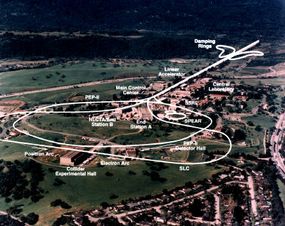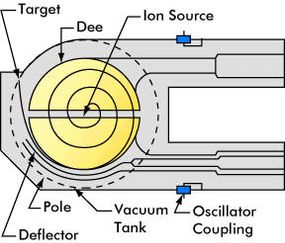A Particle Accelerator
Did you know that you have a type of particle accelerator in your house right now? In fact, you are probably reading this article with one! The cathode ray tube (CRT) of any TV or computer monitor is really a particle accelerator.

The CRT takes particles (electrons) from the cathode, speeds them up and changes their direction using electromagnets in a vacuum and then smashes them into phosphor molecules on the screen. The collision results in a lighted spot, or pixel, on your TV or computer monitor.
Advertisement
A particle accelerator works the same way, except that they are much bigger, the particles move much faster (near the speed of light) and the collision results in more subatomic particles and various types of nuclear radiation. Particles are accelerated by electromagnetic waves inside the device, in much the same way as a surfer gets pushed along by the wave. The more energetic we can make the particles, the better we can see the structure of matter. It's like breaking the rack in a billiards game. When the cue ball (energized particle) speeds up, it receives more energy and so can better scatter the rack of balls (release more particles).
Particle accelerators come in two basic types:
- Linear - Particles travel down a long, straight track and collide with the target.
- Circular - Particles travel around in a circle until they collide with the target.

In linear accelerators, particles travel in a vacuum down a long, copper tube. The electrons ride waves made by wave generators called klystrons. Electromagnets keep the particles confined in a narrow beam. When the particle beam strikes a target at the end of the tunnel, various detectors record the events -- the subatomic particles and radiation released. These accelerators are huge, and are kept underground. An example of a linear accelerator is the linac at the Stanford Linear Accelerator Laboratory (SLAC) in California, which is about 1.8 miles (3 km) long.

Circular accelerators do essentially the same jobs as linacs. However, instead of using a long linear track, they propel the particles around a circular track many times. At each pass, the magnetic field is strengthened so that the particle beam accelerates with each consecutive pass. When the particles are at their highest or desired energy, a target is placed in the path of the beam, in or near the detectors. Circular accelerators were the first type of accelerator invented in 1929. In fact, the first cyclotron (shown below) was only 4 inches (10 cm) in diameter.
Lawrence's cyclotron used two D-shaped magnets (called Dee) separated by a small gap. The magnets produced a circular magnetic field. An oscillating voltage created an electric field across the gap to accelerate the particles (ions) each time around. As the particles moved faster, the radius of the their circular path became bigger until they hit the target on the outermost circle. Lawrence's cyclotron was effective, but could not reach the energies that modern circular accelerators do.

Modern circular accelerators place klystrons and electromagnets around a circular copper tube to speed up particles. Many circular accelerators also have a short linac to accelerate the particles initially before entering the ring. An example of a modern circular accelerator is the Fermi National Accelerator Laboratory (Fermilab) in Illinois, which stretches almost 10 square miles (25.6 square km).
Let's take a look inside a particle accelerator.
